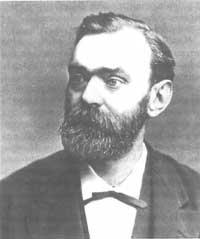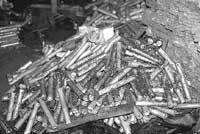Alfred Nobel, chemist who invented dynamite and created peace prize
On more than one occasion we brought some Nobel prize or some scientist who won. On this occasion, on the occasion of the anniversary of the birth, we will talk about the founder of the foundation.
Alfred was born in Stockholm, capital of Sweden. His father, Immanuel Nobel, engineer and inventor, built several bridges and buildings in the city. His mother, Andrietta Ahlsell, was the daughter of a wealthy family. In the same year that Alfred was born, his father's company failed and, to deal with this misfortune, the Nobel family moved to Finland first and then to St. Petersburg.
At first he went to Russia only his father and opened a mechanical factory. There, among other things, he manufactured material to supply the Russian army and invented underwater mines. This success allowed him to take the whole family to St. Petersburg. The young Nobel studied in Russia.

At the age of 17, Alfred Nobel was able to speak in Swedish, Russian, French, English and German. His favorite subjects were literature, poetry, chemistry and physics. However, his father did not want to accept the passion for poetry and, to remove himself from his head, decided to send his son abroad with the excuse of training in chemical engineering. Thus, in the next two years the young Nobel had the opportunity to meet Sweden, Germany, France and the United States.
During his stay in Paris, he met the chemist who invented nitroglycerin three years earlier, the Italian Ascanio Sobrero. Nitroglycerin is a viscous and explosive liquid that is prepared by mixing glycerin and concentrated sulfuric and nitric acids. Being very explosive and unstable, it can explode at any time, so initially no practical use was found.
But Alfred Nobel was fascinated by this invention and was soon reminded of its possible uses in construction. To do this, we had to solve security problems before and find a method to control nitroglycerin detonation.
In 1852 he returned to Russia and went to work in his father's laboratory. He tried to turn nitroglycerin into a useful explosive, but he was not very successful, since many accidents occurred in handling.
When the war ended, his father's business failed. Immanuel and two children, Alfred and Emil, returned to Stockholm. The other two sons stayed in St. Petersburg and gradually managed to get the family business out.
Those who returned to Sweden created a new laboratory. But the truth is that they were not very lucky. In 1864, when they were working, the laboratory explodes. Five workers died as a result of the incident, including Alfred's brother. When the Swedish government learned about the accident, the authorities decided to prevent nitroglycerin production. In addition, the controversy surrounding the explosion provoked public opposition to Nobel. Among other things, the creation of war material and the attraction of catastrophes spread among the population.
However, Nobel did not resign. On a boat docked around Lake Mäla continued with the construction and research of the laboratory. In 1866 he discovered how to handle nitroglycerin safely. It added 25% diatomite to nitroglycerin, obtaining an explosive powder of easy handling, dynamite. To make him explode, Alfredo also invented the detonator. At the same time, Nobel invented the dynamite, beginning to use the diamond drilling crown and the pneumatic drill. All of them, together, meant a total reduction in the cost of numerous construction sites.

From then on, Nobel was enriched by making explosives and exploiting the oil of Baku, the capital of Azerbaijan. Although he had his home in Paris, most of the time he traveled from one side to the other. In this sense, writer Victor Hugo once claimed that Alfred Nobel was the “richest sector in Europe”. However, he continued to investigate the rich wanderers and, in 1876, invented an explosive called Balistite.
At the age of 43, he announced in a magazine that he was looking for an adult and hardworking woman with a high cultural level to collaborate in the domestic and laboratory tasks and that, incidentally, the Nobel herself would accompany him. This is how she meets Austrian countess Bertha Kinsky. But after working in a very short time, Kinsky returned to his village. However, Nobel and the countess remained great friends.
Little by little, Countess Kinsky began to participate in the movement against arms and for peace. All this undoubtedly had a great influence on the Novels. In his last testament he left the order to organize a prize for people and entities working for peace.
He died on 10 December 1896 in Rome, leaving a good of 9,200,000 dollars, all for the Nobel prizes. Initially, these awards were divided into five themes: Physics, Chemistry, Physiology and Medicine, Literature and Peace. Later, in 1968, the Nobel Prize in Economics was created.
Undoubtedly, the greatest honor a scientist can receive is to receive the Nobel Prize. However, the chemist who created the failed awards without honor.





